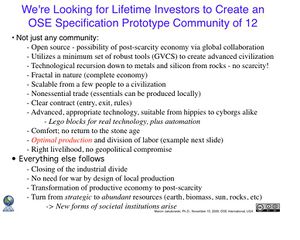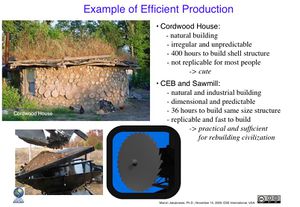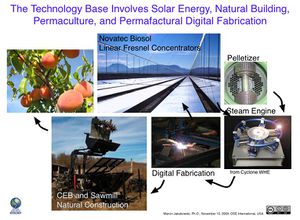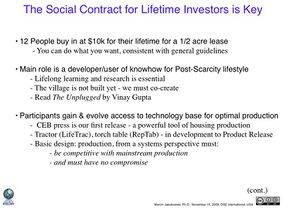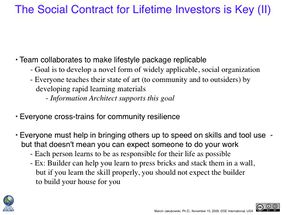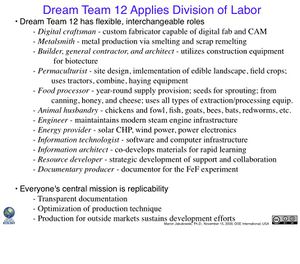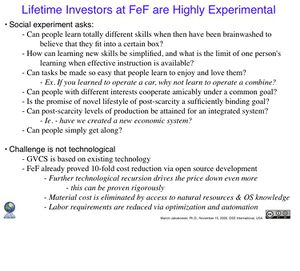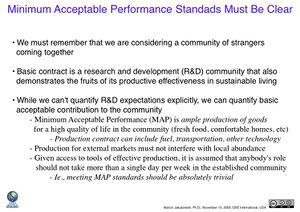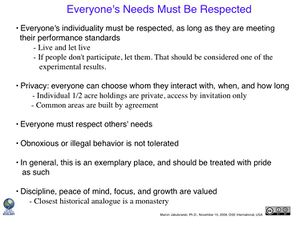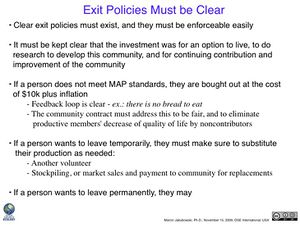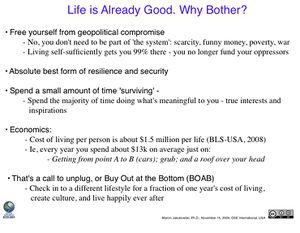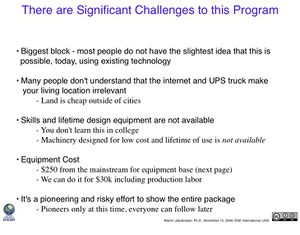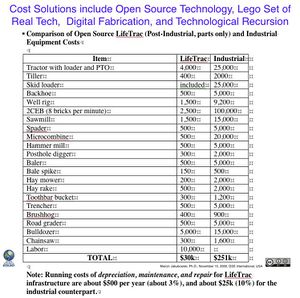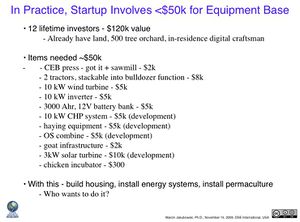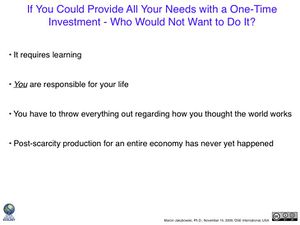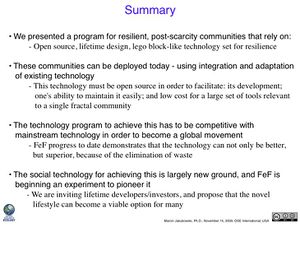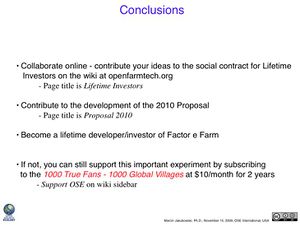Lifetime Investors
![]() It has been suggested that the text on [[::FSCONS 2009 Slides|FSCONS 2009 Slides]] be merged into (added to) this page or section. (Discuss)
It has been suggested that the text on [[::FSCONS 2009 Slides|FSCONS 2009 Slides]] be merged into (added to) this page or section. (Discuss)
Introduction
Here is an abstract from December 2009, plus earlier work on Lifetime Investors from the FSCONS conference of Nov. 2009. See also Investment Portfolio
Abstract
Abstract: This document aims to explain the nature of lifetime investment in Factor e Farm (FeF) . We are seeking dedicated developers for carrying out the development and application of the Global Village Construction Set on-site at FeF. This opportunity is for those interested in first-hand development of the world's first, replicable, post-scarcity, resilient community – free of geopolitical compromise, and founded on a resource-based economy. The goal of this experiment is to demonstrate that: (1), resilient, local, autonomous economies can be created on the scale of as little as 40 acres; (2), these economies can be the basic building blocks of civilization, in that larger units of social organization can consist of a number of these basic units; (3), these units can be made sufficiently functional and effective to allow viral replication; (4) these economies can have a profound and transformative effect on their surrounding communities by setting a good example of resilience; and (5), post-scarcity economies can be created as a viable form of social organization for civilization. This document discusses the value of being an investor, and the basic social contract between investors and FeF. This is intended to lead to an open source, evolving, and replicable governance blueprint for creating post-scarcity, resilient communities, with FeF as the first experimental case in this novel pattern of social organization. The particular flavor of FeF is intended to be not only the world's first, replicable, post-scarcity, resilient community, but also a world-class research center for post-scarcity economic development via open source product development in a resource-based economy.
Download full document (8 pages in Open Office) Download full document (8 pages in PDF)
Comments
1
But on 'exit policies' a person who has completed a house to a livable state should certainly be able to trade rent of the house for any obligations. If the owners would sign some sort of document making OSE the rental manager for the period of their absence (contract could specify a period or just go in 3-month intervals or something) that would meet any requirements to stay there. So the house could be use to house someone working on project or maybe used for people taking classes there, etc. Any rents would be the property of OSE. Just a thought. People have to be able to leave for a while. Otherwise if would feel like a kind of prison!
From FSCONS Presentation
Read about the Lifetime Investors program in the FSCONS 2009 Slides. The description of the program starts in Slide 19. Below, we take slides 19-35, and open them up for review, comments, and suggestions. We are focusing on how the social contract can be designed to create a workable, practical, post-scarcity, resilient community.
The slides below are listed individually, in order. Next to each slide is a description of its content with the space below left for comments. Each slide is up for comments.
Slide 19
We move on to the social technology, which is the real challenge of such a community. We accept that there are limits to how far a single family unit can reach in terms of post-scarcity, integrated economic existence. So we learn from history, and organize villages.
We have an ambitious program in mind, and the community that we're interested in creating is not just any ordinary community. We are looking for people dedicated to create the world's first, replicable, post-scarcity village. There are several unique features.
- Open source - only by global collaboration and winnowing and sifting of what works and what doesn't can we come up with a robust technological and social design.
- We utilize a minimum set of tools - not too large - because then we could not manage/develop/opensource these tools as easily. So we limit ourselves to a wise, sufficient set of choices - but, choices that can still lead to advanced civilization.
- We master our technology base. That means we can produce the necessary technologies locally. This mean that with time, we will apply technological recursion - the substitution of our skill and labor for outside sourcing. This mean - we begin making components, and eventually begin to make the actual feedstocks that make these components. Everything comes from the earth - rocks give you metals and computers.
- We are interested in a complete economy. This means, the village is fractal by design - it is complete in itself, or it can scale to multiple units that form cities and regions. They are resilient because they utilize their local resources. To utilize local resources, technological mastery is a prerequisite.
- The participation contract for the village must be clear. It's a research and development community - entry, exit, policy. This is not just a bunch of hippies in the woods running around with knives and polyethylene.
- Advanced appropriate technology is key. We are not talking about going back to the stone age. We can have all the trappings of modernity, but we can do it ecologically. This could be attractive to back-to-the-landers and technophiles alike. We are building adaptable, lego-block-like technology pieces, and automating production wherever desirable.
- A critical feature is optimal production. We must be able to provide needs efficiently - and this is the point that most hippy-in-the woods efforts are missing. This requires discipline and division of labor.
- There's a huge ethical point to this. There is no need for geopolitical compromise of killing and stealing from one another, leaving hordes of people deprived while a few at the top exist in a search for meaning.
From this design, everything follows. We close the industrial divide between the North and South - as technological advancement can be shared readily via the internet. There is no need for war because production is local. Strategic resources exist no more - as appropriate technology is able to generate needed services from abundant resources of earth, biomass, sun, rocks, etc. We are talking of no less than post-scarcity, new forms of societal organization, and all the tools necessary to get there are now in existence in the digital age.
Comments:
There is a huge discontinuity where the societal structure is barely mentioned. This should be the main focus of this topic as if these are lifetime investors, then they can't be just pawns to be tossed away when something doesn't work out, these are people who have a stake in the success of this venture. Restating the FeF purpose statement doesn't address this, and is better described other places in the site. Make reference to it with a link and get to the meat of what your doing, which is setting up a research and development community.
.
Slide 20
One important point is efficient production. Allow me to demonstrate. We built this cordwood building with 400 human hours of labor for a shell structure without furnishing. This was arduous, irregular, unpredictable. This is not efficient from the replicability standpoint. It is cute.
That's why the CEB Press and Sawmill are parts of the GVCS. See CEB Story for more details. The point is, the CEB and sawmill are efficient, natural, dimensional, and industrial. They are easy to build with, so you need about 10 times less time to build a similar structure. This is practical and sufficient for rebuilding civilization, if that is our goal. The CEB we have, we will be building the sawmill in February.
Comments:
A CEB press doesn't equate to instant housing. It's a tool. Talk about the plan you have for housing and how CEB and a saw mill fit into that plan.
__Demented__
More to the point but inline with the above comment; you need to have house designs that are tried, true, and tested. They need to be safe and turnkey. Most people are not qualified to design their own structure nor should they have to do that work. Talk not only about your plan for housing, but the plans for houses you already have ready to go that have been analyzed and found to be sound. Give people options that are agreeable and also safe and easy to build. The tools are great--fantastic job on the press by-the-by--and necessary but your documentation for the houses themselves needs to be in place so you can reference them directly.
__Demented__
.
Slide 21
The technology plan includes the standard cast of characters: building infrastructure, solar enregy, permaculture, digital fabrication, fuels and steam power.I won't get into the details, except make a few points. Solar linear fresnel design - seen in the picture, as done by Novatec Biosol, is proven - and we want to scale it down to home and village size of about 3kW and up. We believe we can do that if we have access to an open source, modern steam engine - and we propose the Steam Engine Construction Set. Combined with tractor -> hay bales -> pelletizer - we can fuel the steam engine with biomass pellets or the sun - for a combined heat and power (CHP) system. We can then power digital fabrication, to build more tractors and solar power systems, and the tractors can help us grow food. It's not that complicated.
Comments: It's not that complicated, but you'll need a plan. This is a good place to talk about energy infrastructure and how much it is going to cost to build such a thing. Experiences with personal energy budgets, and a realistic and CONSERVATIVE energy usage scenario would also be appropriate here.
__Demented__ Less pictures on this slide and more information. This is one of the harder areas to master in a community because it can get so technically involved. Show me numbers, research, and systems. Also, consider some solar project that is proven like http://www.solarfire.org/ instead of trying to do new stuff with the fresnel design because it saves time, indicates a willingness to use other open source alternatives, and gives you more resources to do the new research that needs to be done. __Demented__
.
Slide 22
The social technology is more complicated, because we need to get a number of diverse people to get along.
The basic program is that you buy in, now we're considering $10k a pop - for a 1/2 acre lifetime lease at FeF. You are free to do what you want with your share.
The contract is that you agree to participate actively in developing and improving the design and infrastructure of a replicable, post-scarcity community. This means a lifestyle of research and lifelong learning, where you must recognize that the village is not built yet. Think of it as a clear slate. And read The Unplugged by Vinay Gupta to see a fictional account quite similar to what we're proposing.
The role of the participants is to not only fund necessary developments through their acceptance fee, but to do development work - to create an infrastructure competitive with and superior to mainstream infrastructures. We do this simply by repackaging existing knowhow in the open framework of open source design. We can do this without compromising any human values, by taming technology towards true human service.
Comments:
Why $10k? Previously it was $5k. Also, when you consider that your paying for the privilege of renting a half acre of undeveloped land that will have no running water, no electricity, no internet, and no mailing address you'll have to do a bit better in laying out how that money will be used. I also want an expectation of other costs based on how much it will require to get the above basic living conditions. Most importantly, I want complete full disclosure of finances for this community for all revenue sources.
.
Slide 23
The team collaborates to make the entire package of lifestyle replicable - to those following these footsteps. While the development team must have pioneering skills, many can follow once the package is created.
Comments:
I like this.
.
Slide 24
Comments:
You desperately need a mechanical engineer, architect, , or someone well versed in structural engineering. Your building houses and a community here and you don't what them to fall down.
__Demented__ Architects are not "well versed" in any engineering. It isn't what they do. Civil engineers do building structure, soils, and waterways. Mechanical engineers deal with anything that moves (all your tools to date). Electrical engineers do electronics and a lot of automation control. Architects make things look good and pick out materials and dimensions based on customer desires and aesthetics. You desperately need engineers of all types but you could do without architects for a long, long time--though not indefinitely since looks do matter once things are functional.
The comment about not wanting houses to fall down is critical. Have structure designs that are pre-designed so people aren't trying to build crazy stuff without a clue of the dangers or concerns involved. Also, incorporate some sort of quality control into that system so basic mistakes aren't made. People with experience creating documentation for all this stuff would be critical since once the system is designed and built, it must be replicated. __Demented__
Slide 25
Comments:
I disagree that society building is highly experimental. The United States alone has over two hundred years of documented experimental communities and societies. Going into this without doing the proper research is irresponsible. If a company with over a million employees can keep them semi-honest, on task, happy and productive doing boring work, then you should be able to do 10x better.
.
Slide 26
Comments:
This is good but you need to also talk about leadership structure. I understand that Marcin will most likely take a figure head position due to his contributions, but we will need an effective village/community leader with experience managing and mediating people and problems.
__Demented__
And what if meeting MAP isn't trivial? How will setbacks and emergencies be addressed in the community? How will initial start up be handled? Once the system is steady-state, I agree things should be easy, but the transient response in startup and during emergencies is the worrisome part. You need plans in place for those eventualities more than you need a plan for what to do with all your ample free-time once "the good life" has been reached. Let's hear some talk about expectations for startup on an individual level.
__Demented__
Slide 27
Comments:
Some people actually like living close together. I believe that you could attract a more diverse group by allowing people to "go in" on a 1/2 acre so they can build something more like a villa with shared common space. Otherwise you would end up with a village of hermits or at best an extension of urban sprawl.
__Demented__
I lived on a commune for a time growing up. My experience is that people get too close in their quest to "be one" with each other and to "get back" to nature and this drives some pretty serious wedges into established and building relationships. I think most communes fail because a lot of the people who start them--I believe most but I'm trying to be fair--have no sense of personal space. The majority of the world lives in individual houses--at least in terms of nuclear family units--rather than in sprawling common areas. I think it would be critical to maintain private residences but stress a common partnership with shared responsibilities and obligations. The hippies failed for a reason--at least the ones I was with!
__Demented__
.
Slide 28
Comments:
You need entry procedures as well. You also need to be explicit about who has the power to determine when it is time to force someone to exit the premise. Otherwise, good.
.
Slide 29
Comments:
In Oklahoma right now, it would take roughly a year to two years to meet the $10k buy-in period for an individual making $20k-30k a year who has medical, housing, food, and personal expenses. You need to characterize the candidates a bit better. What about people with a wife and kids? What about someone who is retired and looking for something new? Think about where someone needs to be in life to make a contribution.
__Demented__
Maybe get away from the tried and not-so-mainstream rhetoric about the "system" and the messed up government. I'm on-board with the idea of post-scarcity but I have no interest in your political ideologies. I'm a suburbanite with a degree and a committed relationship. I've experienced the commune lifestyle and most people I know--i.e. the majority of people with an education who live in or near a city--have no interest in this. Apply to their baser instincts to save money and do what they like. Live the ideology at the door.
__Demented__
.
Slide 30
Comments:
This list needs to be better organized and expanded. You want to scare the ever living crap out of everyone who sees this stuff and if they are still ok with it, then talk to them. The other parts of this site should be enough to get people initially interested.
.
Slide 31
Comments:
Again, cost of infrastructure is only a small part in the total cost of constructing a community.
.
Slide 32
Comments
1
Big round thousand numbers are nice but you'll have to break up those costs or reference where those costs are broken up better. Also, stop using optimistic numbers when you can't guarantee them! Its insulting and dishonest. Transparency and openness only please.
2 - Marcin
Documentation is scattered, I agree. But which numbers are optimistic? Empirical evidence shows that they are being met. In fact, The Liberator has far exceeded expectations, within the initial proposed cost structure of $3-5 turnkey product, and less for parts only. $3500-5500 is the initial release offer. We were aiming at 3-5 bricks per minute, and we are ending up with something that looks like 12-16 at the end of the day. See http://blog.opensourceecology.org/?p=1259
.
Slide 33
Comments:
.
Slide 34
Comments:
.
Slide 35
Comments:
.
